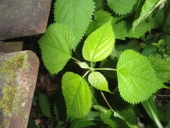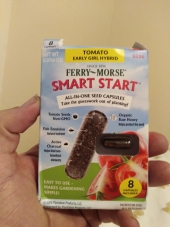Here is a picture of my best radish. It grew from a big seed ball full of various radish seeds. We're planning on harvesting this radish and its greens tomorrow. Surprisingly, bugs have left the leaves alone. I chose radish because they're good for soil.

CC BY-SA
It rained today. The mulch is just a bunch of weeds that I finally chopped down a month or two ago. It's working well. A balsam and tomato plants are in the background.
Here is a picture of an okra plant and some clover. I planted them by putting their seeds on the dirt and covering them with compost, but I would use any organic soil. It looks like the clover will act as a living mulch.

CC BY-SA
I used the sticks to mark where I planted seeds. By this point, I'm not spreading weeds apart to plant seeds; I'm spreading apart mulch. I think the okra seeds had more compost than the clover seeds, so I put some main crop seeds on dirt, cover with a little compost, sprinkle the clover seeds, and then put a little more compost on top.
Lastly, here's my first orange tomato. Many of my tomato transplants have thrived without much water. I'm letting them sprawl like Fukuoka recommended. This is a better boy, and it hides its tomatoes much better than a beefsteak. Shown are two pieces of found bamboo that I'm using to prop up tomatoes.

CC BY-SA
Bamboo is pretty handy, and there are some clumping varieties that are not invasive. One thing about natural farming is that some plants may be too domesticated to just throw to the wild, but if our plants go to seed, then they probably get wilder, year after year. My Brandywine is not doing as well. I took all of my transplants, put them on the ground, and put compost around them. (
https://piconic.co/p/kete/288862411555999744) As the days went by, I shored up the compost up as necessary, but I don't transplant like this anymore. Most of the beefsteaks didn't make it. They might have needed water or caught a disease, but they collapsed.







